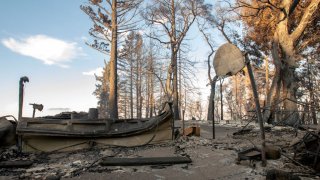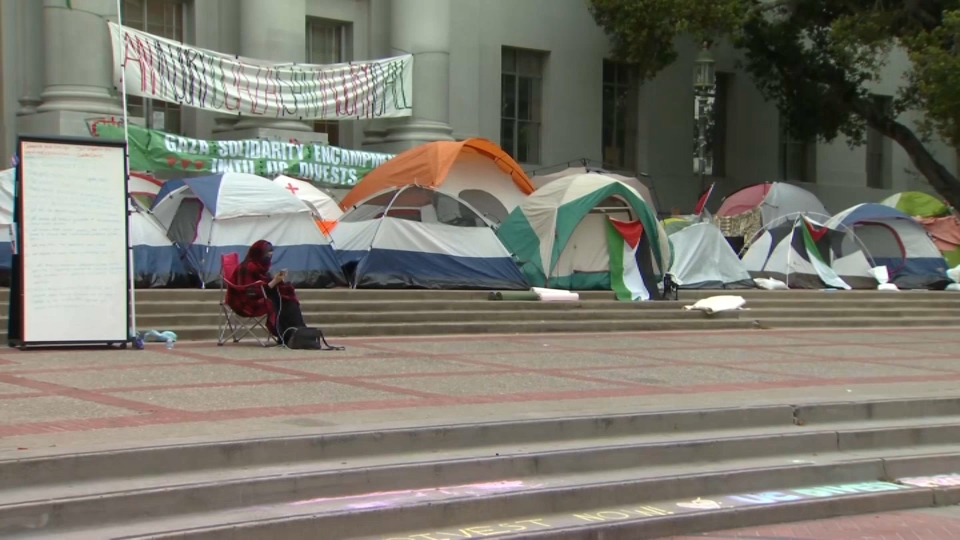
Santa Cruz County supervisors discussed rebuilding efforts for CZU Lightning Complex Fire victims, but for some, that process may extend past 2021 as they potentially face another environmental disaster.
In many areas of the county, the blaze ravaged homes, as well as trees and other flora that stabilized the land and soil -- making the area very susceptible to landslides.
"It is this increased geologic hazard because of the change in the landscape, loss of vegetation, etc., there is a high risk of debris flow landslides," County Planning Director Kathleen Molloy said. ""This (threat) exists for someone who is not rebuilding or even someone who is outside the burn area."
All burn areas in the county are threatened by landslides, but the biggest threat is around the Bonny Doon side of the fire, north east of Davenport, according to County Communications Manager Jason Hoppin.
"There is some erosion control and some things that can be done to reduce the extent of (landslides), but really in the first couple of winters at least it can't be fully mitigated ahead of time. The strategy includes evacuating people in these areas at risk," Molloy said.
What that means for fire victims in the landslide risk area is that they would have to wait until the county geologist and other assessors determine whether the soil is sturdy enough or find another place to live.
"It doesn't make any sense to rebuild a house that is going to slide right back into the creek as soon as it rains," Hoppin said.
Local
Hoppin said that even a small amount of rain could spark landslides, and that dirt is already moving now -- indicating a significant change in the landscape.
In the month-long blaze, 911 homes were destroyed and 86 damaged in Santa Cruz County. Preliminary estimates place the total damage costs around $340 million, which includes damage to public infrastructure, including roads and water supplies.
Nearly all the damage was in districts 5 and 3, where Bonny Doon is, according to the county planning department.
"Coordinating with the county geologist, we are trying to put together a screening tool to let people know whether they have to worry about (landslides and other geologic hazards) or not," Molloy said.
The rebuilding process will look very different depending on where a home was located and if everything was up to code, but everyone will need to get clearance from the county geologist.
"Some of the damage has occurred with roads so that will be another type of coordination that should occur," Molloy said. "So tentatively, if you are not in an area that is a fairly straightforward site you made need clearances from environmental health regarding your septic, from the fire district regarding your road access."
There are a few more steps, in addition to a geological assessment, that need to occur before rebuilding can start. These include damage assessment by Cal Fire, insurance and FEMA claims submitted by residents, and the pick-up of all hazardous materials and debris from the fire by the county and federal waste specialists, among many others.
"We are at the starting point of this and we know it is going to be some time," District 5 Supervisor Bruce McPherson said. "None of us can recognize the hopelessness and emptiness of the 900-plus people who have lost their homes, so I just want to make sure you know that we are trying to work as quickly as we can."
The board of supervisors unanimously approved multiple regulatory changes to make it easier and quicker for fire victims to recover and rebuild. Those changes include eliminating the need for demolition permits after the approved debris removal processes, as well as eliminating or delaying some building-related fees.
In fact, nearly $6,000 in fees were removed, but there are still about $10,000 worth of rebuilding fees that cannot be eliminated because of staff and consultant expenses, according to Molloy.
Those fees could be paid in full by insurance, but that is subject to each person's coverage.
The board also provided direction to the county's planning department to increase resources available to process building and related permits for reconstruction; as well as direction to explore flexibility on the timeline for state-required septic upgrades and alternative water and power options for temporary residents.
The board also increased options for temporary housing solutions for fire evacuees including those on fire-damaged properties, approved hotel stays for more than a month for displaced residents, and is initiating a process to allow reconstruction of structures that were non-permitted or not up to code.
"We took lessons from other communities that have experienced similar events so hopefully we aren't reinventing the wheel and in fact will have a better wheel for people as they rebuild," District 3 Supervisor Ryan Coonerty said.
A new urgency ordinance was also passed by the board that prohibits price gouging for goods, services and housing. Prices cannot increase more than 10 percent in the 30 days after a disaster declaration, and the board can extend those by 30-day intervals as needed.
Violations are a misdemeanor and punishable by fines of $1,000, a year in jail, or civil penalties up to $10,000.
The board will hold a special meeting Sept. 29 to discuss the threat of landslides and will continue discussing the rebuilding process during their October 6 meeting.
Those who are interested in attending can find the information on the county's website.
This story was written and reported by Jana Kadah for Bay City News.



